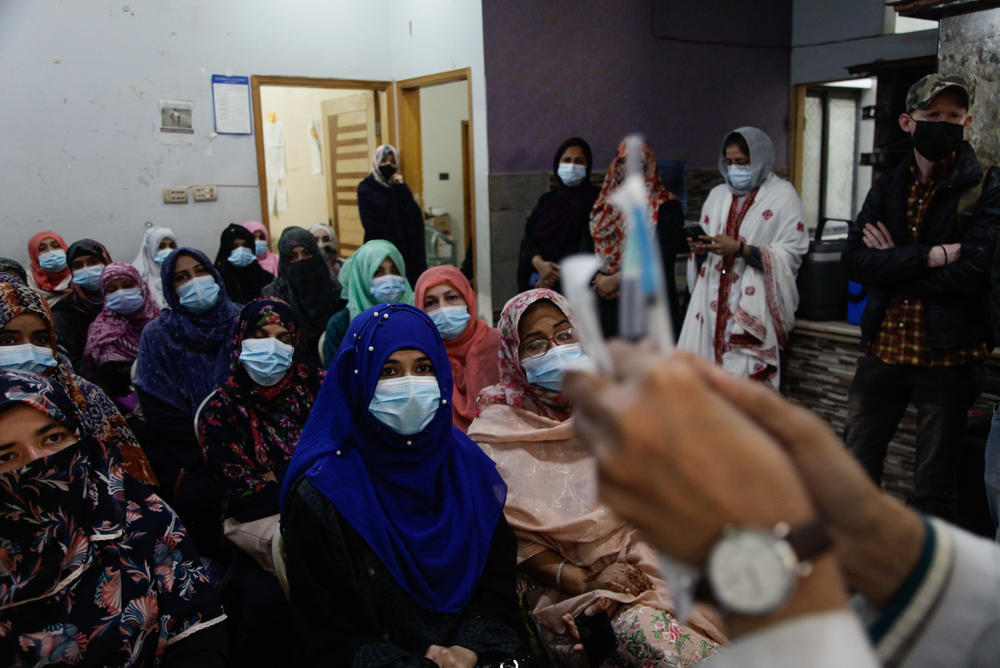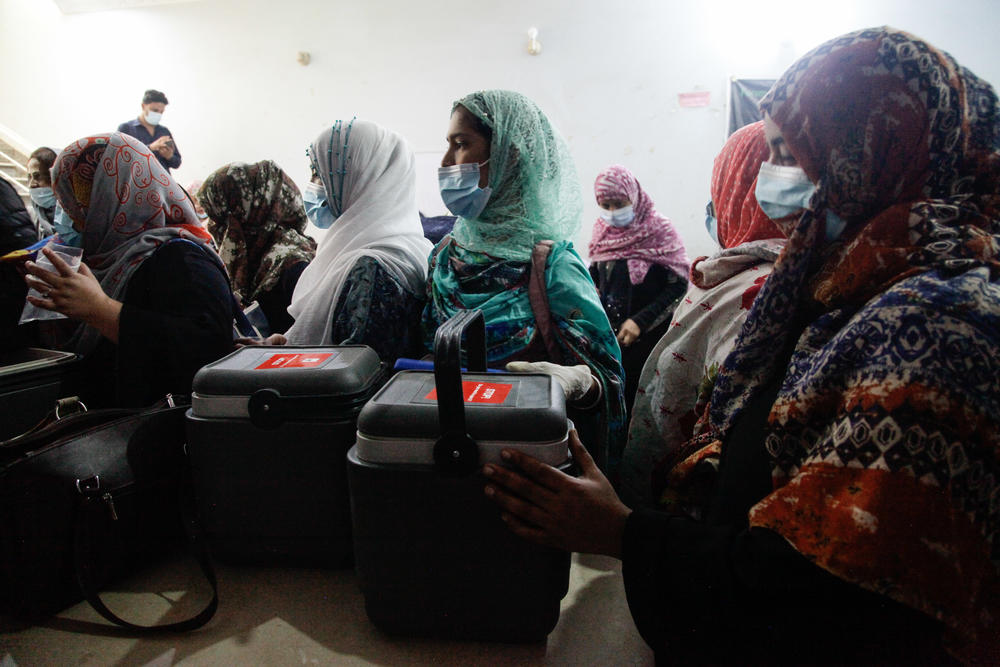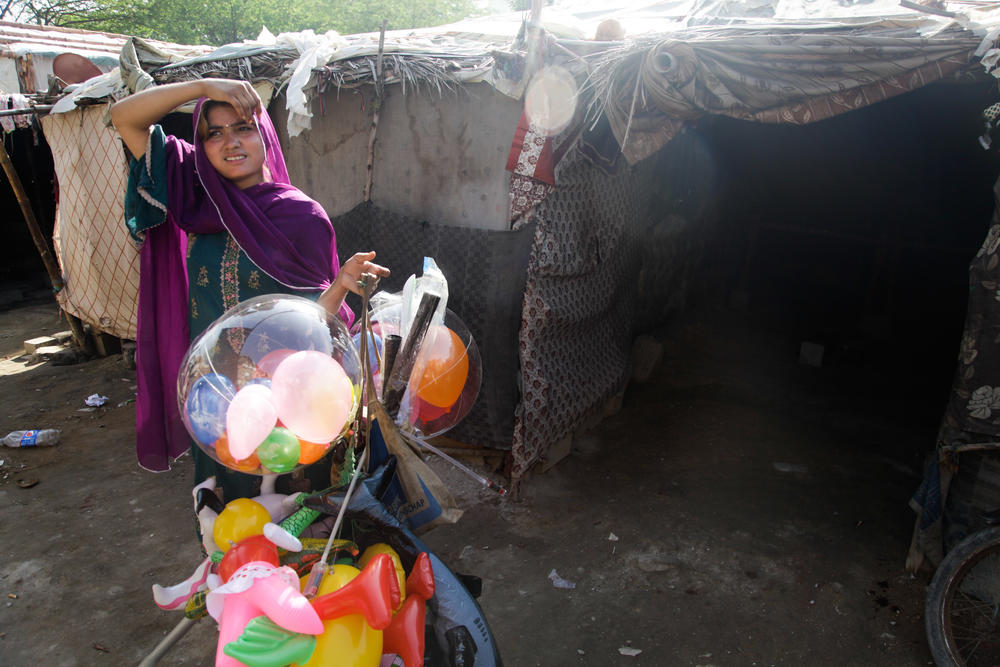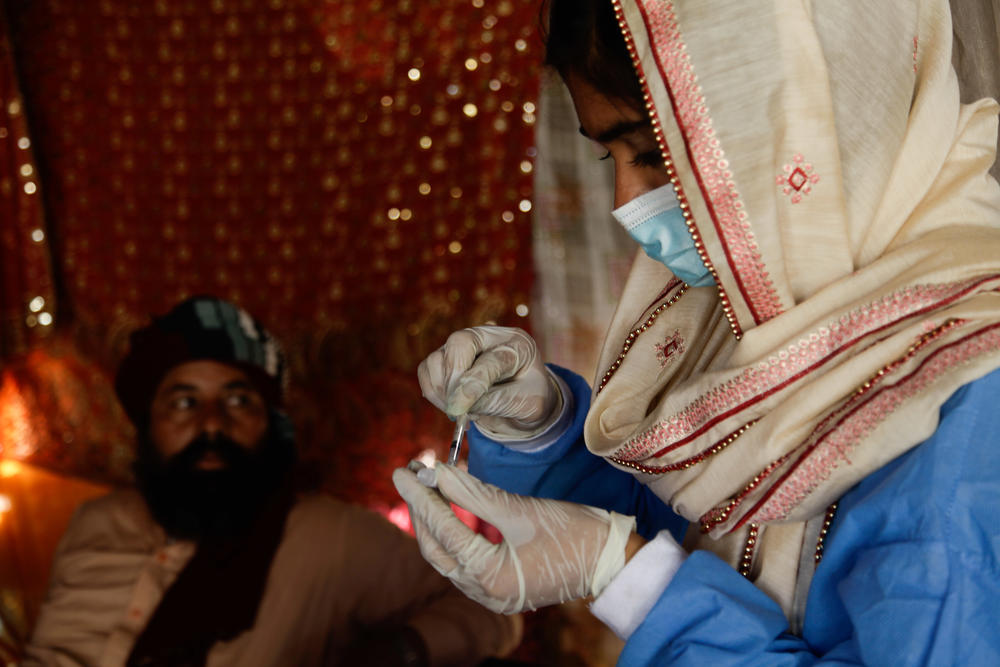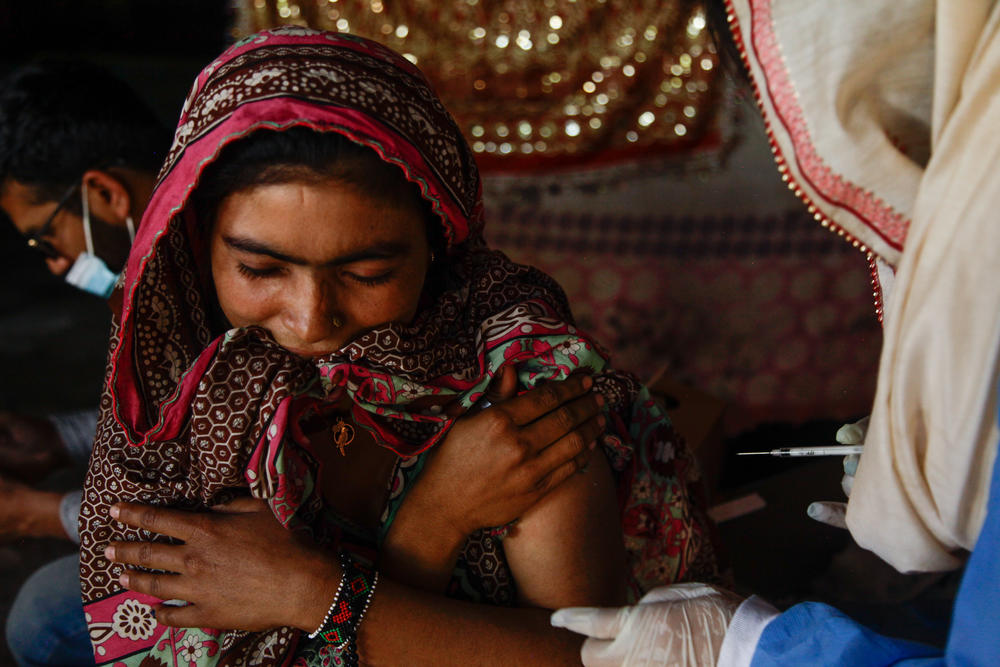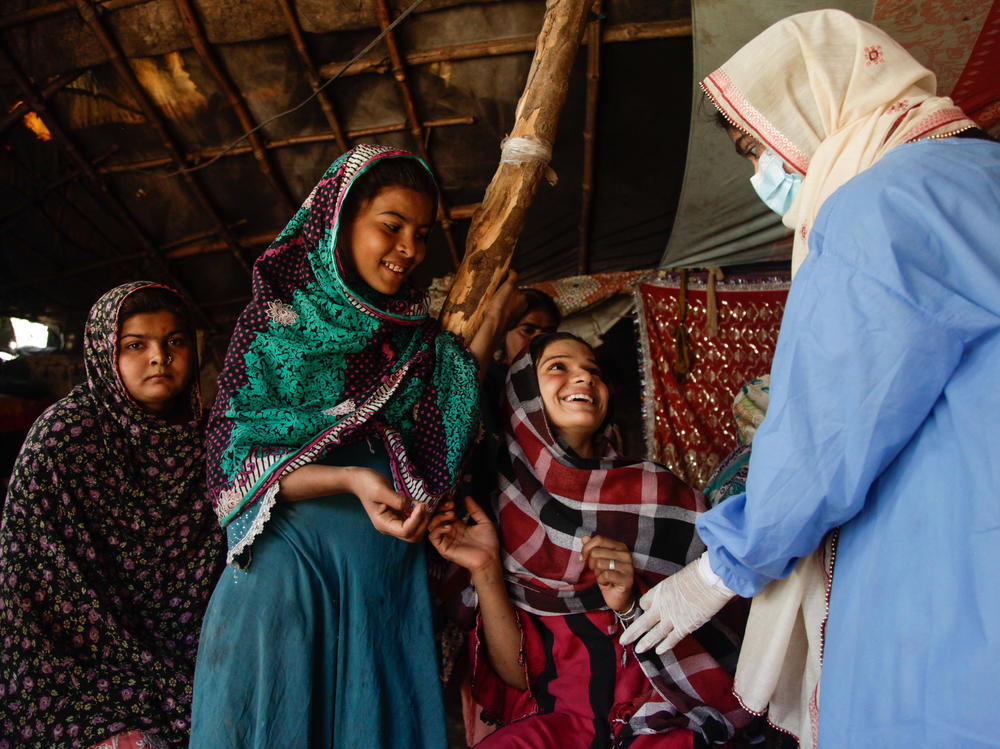Section Branding
Header Content
Pakistan has a big idea: Send 13,000 teams led by women to vaccinate the hesitant
Primary Content
KARACHI, Pakistan – A doctor gives a pep talk to some two dozen women sitting in a hall of a medical center. "We've got Pfizer. We've got Moderna. We've got Sinovac," says Dr. Kishwar Tanwir, who oversees vaccinations in the Pehlwan Goth district of the Pakistani city of Karachi.
The women were about to go door-to-door to offer COVID-19 jabs on a recent February day – part of some 13,000 teams led by women that were dispatched across the southern province of Sindh to vaccinate some 12 million people over the age of 12.
This dramatic intervention by the Sindh government aims to vaccinate a cohort they have struggled to reach: some 25% of residents who have not had their first dose, despite vaccines being widely available for the past year through supplies provided by the U.N.-backed COVAX program, the U.S. and China.
"The objective of the door-to-door campaign was basically to focus on these people," says Dr. Sohail Raza Shaikh, the government's point person for COVID-19. "People who are less literate, less aware about the COVID-19 vaccine."
It's not known how many countries have tried to bring the vaccine to people's doorsteps, but senior Pakistani health officials said they were not aware of any other effort this large anywhere else. If it works, it could be a model for other developing countries, struggling to boost their vaccination rates. Pakistan's eventual goal: bringing the Sindh province's first dose vaccine rate to 90 to 95%.
Transportation: Rickshaw. Cargo: Coolers full of vaccines
Pakistan dispatches female health workers for these sorts of public campaigns because they're more likely to get access to women in conservative households who don't speak to men. They have years of experience, frequently fanning out across Pakistan to administer the oral polio vaccine to millions of children.
At the medical center in Pehlwan Goth, Namra, a 21-year-old health worker waits for a medic to fill her blue cooler box with a mix of different vaccines stored in a deep freezer. She's only got one name, like many people here.
She jumps into a rickshaw to travel to her assigned area some five minutes away, accompanied by her team – two sisters: Sajeela and Sajida. One is a social mobilizer: Her job is to convince residents to get vaccinated. The other sister enters data about the people they're vaccinating.
They reach the Hindubasti, a ramshackle patch of huts dominated by Hindus and Sikhs, wedged between leafy nurseries and a college. They weave through narrow alleyways, stepping around garbage and puddles. The women turn a corner and enter the grounds of a Hindu temple.
Namra is meant to vaccinate door-to-door, but she says she'd rather do it in the temple. The Hindubasti is a small area, she says, and residents can easily find her here, adding "This is a very dirty area – this is the only clean place."
She respectfully takes off her shoes and enters the temple, where colorful statues of Gods and flowers adorn a shelf. Her gesture is striking in a Muslim-majority country where Hindus are often looked down upon.
Convincing the hesitant to get their dose
Her two colleagues head to the nearest house to start mobilizing people to come to the temple to get vaccinated. They greet a woman, Kamli, sitting with her husband in a patch of sunlight outside their hut.
Kamli says she's not vaccinated because she's got kidney stones. She's worried the vaccine will make her sicker, and she can't afford a doctor. "My husband is a balloon seller," Kamli says. "We barely eat bread."
The health workers prod her to get vaccinated at the temple. She shrugs.
In the next hut, Mohammad Shuaib, 38, insists he got his first injection in December but hasn't got around to his second. Health workers find Birma Lal – around 40 – shaving in his front yard. He says he'll come after he smartens up. His wife promises to go once she finishes hand-washing the laundry in a shallow tub.
None of them turn up.
Then the health workers head next door, where a man in his mid-30s, Kamran, is sitting in front his hut on a charpoy, a bed made of woven rope. He says he's had his first shot, but his relatives – gesturing to the men standing around him – don't want to be vaccinated at all. "There's a rumor it could affect your sexual powers or even kill you," he says.
As he chats, Namra, the vaccinator, leaves the Hindu temple and passes Kamran's house. "Only one woman came by," she says, for a vaccine dose at the temple.
Then, Namra sees a few people milling around Kamran's house. She puts her cooler box filled with vaccines on Kamran's charpoy – right beside him. It might be grubby, but there's people she might be able to convince.
The mood shifts.
Namra starts offering vaccines to one of Kamran's unvaccinated relatives, Prakash. "I've got American vaccines, Chinese vaccines," she says, gesturing to her cooler box. He asks for Pfizer, and Namra quickly gets vial. She injects him, and makes him sit for 15 minutes so she can observe for side effects. Her colleagues take down his details.
Watching this, laborer Sana Tandharam asks to get vaccinated. "I was waiting for other people to get vaccinated first!" he exclaims.
A line gathers. Other health workers turn up to support Namra – a young man helps out on entering the data of residents about to be vaccinated. Another support worker comes to encourage more people to come to Kamran's house.
Women wait for their turn as their toddlers cling to their legs. Giggling teenage girls cluster on another charpoy. Then it's the turn of 13-year-old Aarthi. Her shirt is so tattered that Namra injects the vaccine into her arm — through a hole in her sleeve.
A progress report on the door-to-door effort
Ten days into the two-week campaign, Shaikh, the Sindh point person for COVID-19, says they're doing well. His data shows that they've vaccinated just over half their target of 12 million people with their first dose. He says they'll run another campaign in late March.
"Now that it's been done here," he says of the door-to-door effort, "it can be replicated in other parts of Pakistan. I would suggest that this is a good model."
This model could be done in other developing countries – but it's expensive, says Bill Gates of the Bill and Melinda Gates Foundation (which is a funder of NPR and this blog). He was in Pakistan in mid-February to see the country's polio vaccination efforts firsthand and spoke to reporters.
"The polio campaign has used to house-to-house basically in the entire world, and it's not used for much else," Gates says. "It's expensive. But if you want to get, well over 90% coverage, 95% coverage, certainly in developing countries, that's the only way you'll get to that level."
Back in the slum, it's the late afternoon and Namra thanks Kamran for letting her work in his yard. Her team packs up and walks through a communal square where teenage girls are washing laundry in tubs. When they see Namra and her cooler box, they squeal and line up for a shot: It's the most exciting thing on a day of drudgery. Young men see the women, and they gather too.
Namra walks to the nearest hut, puts down her vaccine cooler box on a charpoy, pulls out a sterile syringe and starts again.
Copyright 2022 NPR. To see more, visit https://www.npr.org.
